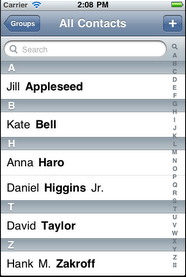Sencha Touch
 A Sencha Touch app with an iOS6 theme | |
| Developer(s) | Sencha |
|---|---|
| Stable release | 2.3.1 / November 8, 2013 |
| Development status | Active |
| Written in | JavaScript |
| Operating system | Android, iOS, BlackBerry, Kindle, Windows Phone, Tizen |
| Available in | English |
| Type | JavaScript library |
| License | GPLv3 or commercial |
| Website | www.sencha.com/products/touch |
Sencha Touch is a user interface (UI) JavaScript library, or framework, specifically built for the Mobile Web. It can be used by Web developers to develop user interfaces for mobile web applications that look and feel like native applications on supported mobile devices. It is fully based on web standards such as HTML5, CSS3 and JavaScript. Sencha Touch aims to enable developers to quickly and easily create HTML5 based mobile apps that work on Android, iOS, Windows, Tizen and BlackBerry devices, and produce a native-app-like experience inside a browser.
Version history and support
Sencha Touch is a product of Sencha, which was formed after popular JavaScript library projects Ext JS, jQTouch and Raphaël were combined.[1] The first release of Sencha Touch, version 0.90 beta, was made available on July 17, 2010. This beta release supported devices running Android, and iOS (on iPhone, iPod touch, iPad). Subsequently the first stable version, 1.0, was released in November 2010. Version 1.1.0 added support for devices running BlackBerry OS version 6. The latest release, Sencha Touch 2.3.1, was released in November, 2013 and is designed to run on the following browsers and platforms: Android browser, Google Chrome for Android, BlackBerry 10, Bada Mobile Browser, Kindle Fire Browser, Windows Phone 8 and Windows 8 IE10 and Mobile Safari. Sencha Touch 2.3.1 contains support for the Tizen browser. There are no announced plans to support Firefox Mobile.
Features
Sencha Touch includes a set of graphical user interface GUI-based controls (or components) for use within mobile web applications. These components are optimized for touch input. The components are: buttons with device specific themes and effects; form elements such as text fields for email, date picker, and address; sliders, selectors, and combo-boxes; a list component with momentum-scrolling and an index bar; a minimal icon set; toolbars and menus; movable tabs; bottom toolbars; and a map component with support for multi-touch gestures such as pinch and zoom.[2]
All the components can be themed according to the target device. This is done using SASS, a stylesheet language built over CSS.
Sencha Touch has eight in-built transition effects including slide over or under the current element, pop, flip, and cube. It supports common touch gestures built from touch events, which are Web standards but supported only by Android, iOS, and some touch enabled devices. These are tap, double tap, swipe, scroll, and pinch.
Comparison to native applications
Native applications on mobile devices have access to device components such as the compass, and microphone[3] which Sencha Touch can access through the use of a native shell such as Cordova. As mobile browsers and devices have evolved to meet emerging standards, APIs and components such as WebSockets, GPS, camera and accelerometers have become available to mobile web applications, with GPS specifically supported by Sencha Touch.[4] Sencha Touch can be used along with Cordova or Phonegap or its own native packager, to create applications native to a mobile device that have access to currently native-only components, and which can be made available from app marketplaces. As of Sencha Touch 2.3, Cordova is the favored packaging technology.[5]
See also
References
- ↑ "Ext JS + jQTouch + Raphaël = Sencha | Blog". Sencha. 2010-06-14. Retrieved 2013-09-21.
- ↑
- ↑ "Sencha Touch: The HTML5 Mobile App Framework". Mobile.tutsplus.com. 2010-07-08. Retrieved 2013-09-21.
- ↑ "Safari on iPhone & iPad 4.2: Accelerometer, WebSockets & better HTML5 support | Breaking the Mobile Web". Mobilexweb.com. 2010-11-23. Retrieved 2013-09-21.
- ↑ "A Sencha Touch MVC application with PhoneGap | Learn". Sencha. Retrieved 2013-09-21.
Bibliography
- Jesus Garcia and Anthony De Moss, Sencha Touch in Action (Early access edition), ISBN 978-1-61729-037-4.